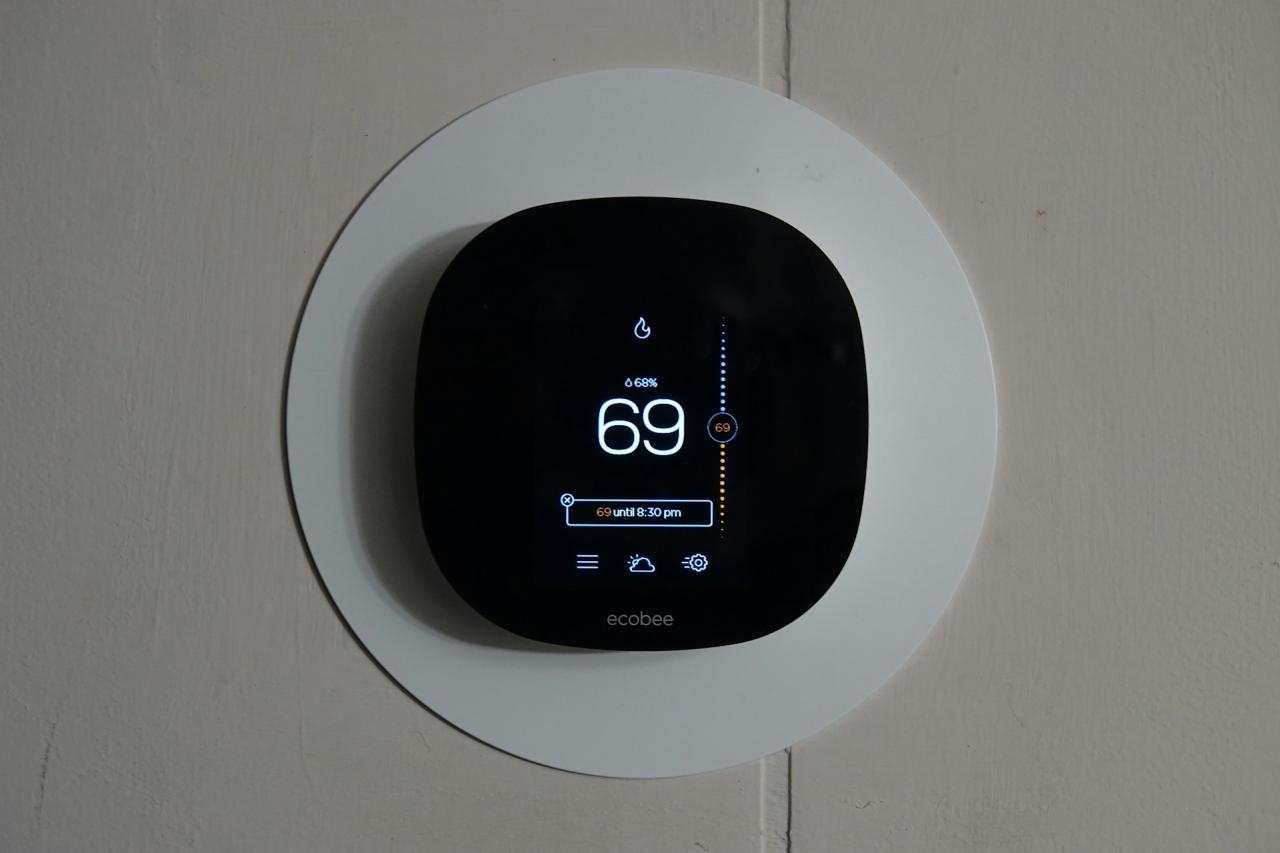How Smart Thermostats Enhance Interior Comfort

Exploring the realm of smart thermostats and their impact on interior comfort, this introduction sets the stage for an enlightening discussion filled with insights and practical information to captivate readers.
Detailing the features and benefits of smart thermostats, this paragraph aims to provide a comprehensive overview of the topic at hand.
Introduction to Smart Thermostats
Smart thermostats are innovative devices that revolutionize the way we control the temperature in our homes. Unlike traditional thermostats that require manual adjustments, smart thermostats can be programmed and controlled remotely using a smartphone or other smart devices.
Features and Capabilities of Smart Thermostats
Smart thermostats come with a range of features and capabilities that set them apart from their traditional counterparts. Some of the key features include:
- Wi-Fi connectivity: Smart thermostats can connect to your home's Wi-Fi network, allowing you to control the temperature from anywhere.
- Learning capabilities: These devices can learn your schedule and adjust the temperature accordingly, helping you save energy and money.
- Integration with smart home systems: Smart thermostats can be integrated with other smart home devices, such as voice assistants, for seamless automation.
- Energy usage tracking: They provide insights into your energy usage, helping you make informed decisions to reduce your carbon footprint.
Benefits of Using Smart Thermostats in Enhancing Interior Comfort
Smart thermostats offer a plethora of benefits that contribute to enhancing interior comfort in your home. Some advantages include:
- Customized temperature settings: You can create personalized temperature schedules to ensure your home is always at the perfect comfort level.
- Remote access: Control your thermostat from anywhere, ensuring your home is cozy when you arrive.
- Energy efficiency: By optimizing your heating and cooling patterns, smart thermostats help reduce energy waste and lower utility bills.
- Improved air quality: Some smart thermostats monitor air quality and humidity levels, creating a healthier indoor environment.
Automation and Customization
Smart thermostats offer the convenience of automating temperature adjustments based on users' preferences, leading to enhanced interior comfort. By programming schedules or using sensors to detect occupancy, these devices can ensure that the temperature is always at the desired level without manual intervention.
Customization Options with Smart Thermostats
Smart thermostats provide a range of customization options to cater to individual preferences and lifestyle. Users can set specific temperatures for different times of the day, create personalized schedules, and even adjust settings remotely through smartphone apps. Some models also offer features like geofencing, learning algorithms, and integration with smart home systems for added customization.
Impact of Automation and Customization on Interior Comfort
The automation and customization capabilities of smart thermostats have a significant impact on interior comfort. By ensuring that the temperature is always adjusted to meet the users' preferences, these devices create a more comfortable living environment. The ability to customize settings according to individual needs not only enhances comfort but also helps in energy efficiency, ultimately leading to a more pleasant and cost-effective home environment.
Energy Efficiency

Smart thermostats play a crucial role in optimizing energy usage within a home, leading to increased energy efficiency. By utilizing advanced technology, these devices help in reducing energy wastage and lowering utility bills while maintaining a comfortable indoor environment.
Energy-Saving Features of Smart Thermostats
- Programmable Schedules: Smart thermostats allow users to create customized heating and cooling schedules based on their daily routines. This feature helps in automatically adjusting the temperature settings when occupants are away or asleep, leading to significant energy savings.
- Learning Capabilities: Some smart thermostats have the ability to learn the household's preferences and adjust the temperature settings accordingly. This adaptive feature helps in avoiding unnecessary heating or cooling, further enhancing energy efficiency.
- Remote Access: With the option to control the thermostat remotely via a smartphone app, users can adjust settings even when they are not at home. This feature enables efficient energy management by ensuring that heating or cooling is only used when needed.
- Energy Usage Reports: Smart thermostats provide detailed reports on energy consumption, allowing users to track their usage patterns and identify areas where energy can be saved. This information empowers homeowners to make informed decisions to reduce energy wastage.
Relationship Between Energy Efficiency and Interior Comfort
Smart thermostats not only contribute to energy savings but also enhance interior comfort by maintaining consistent temperatures throughout the home. By optimizing energy usage and ensuring efficient heating and cooling, these devices create a comfortable living environment that is conducive to the well-being of occupants.
The balance between energy efficiency and interior comfort is achieved through the intelligent control and management of heating and cooling systems, providing a harmonious blend of sustainability and coziness within living spaces.
Connectivity and Control
Smart thermostats offer the convenience of being controlled remotely through smartphones or other devices, allowing users to adjust the temperature from anywhere. This feature provides a seamless way to maintain an optimal indoor environment without the need to physically interact with the thermostat.
Importance of Connectivity in Maintaining Comfort
- Remote Access: The ability to control the thermostat remotely ensures that you can adjust the temperature before arriving home, ensuring a comfortable environment upon arrival.
- Scheduling: Connectivity allows users to create customized schedules based on their daily routines, ensuring that the heating or cooling system operates efficiently and maintains comfort throughout the day.
- Integration with Smart Home Devices: Smart thermostats can integrate with other smart home devices, such as smart lights or sensors, to further enhance the overall comfort and convenience of the indoor environment.
Examples of Connectivity and Control Features
- Geofencing: Smart thermostats can use geofencing technology to detect when users are approaching home and adjust the temperature accordingly, ensuring comfort upon arrival.
- Voice Control: Some smart thermostats are compatible with voice assistants like Amazon Alexa or Google Assistant, allowing users to adjust the temperature using voice commands for added convenience.
- Usage Reports: Connectivity enables users to track their energy usage and make informed decisions on how to optimize their heating and cooling settings for both comfort and energy savings.
Integration with Smart Home Systems

Smart thermostats have the capability to integrate with other smart home devices and systems, creating a cohesive and interconnected smart home ecosystem. By connecting with devices such as smart lighting, security cameras, and voice assistants, smart thermostats can enhance the overall functionality and convenience of the home.
Benefits of Smart Home Ecosystem
- Increased convenience: By integrating smart thermostats with other smart devices, homeowners can control multiple aspects of their home environment from a single interface or through voice commands.
- Enhanced automation: Smart home systems allow for seamless automation of tasks such as adjusting temperature settings based on occupancy or time of day, creating a more efficient and comfortable living environment.
- Improved energy efficiency: Integration with smart devices like occupancy sensors and weather monitoring systems enables smart thermostats to optimize energy usage and reduce utility costs without sacrificing comfort.
Impact on Interior Comfort
- Personalized comfort settings: Through integration with smart home systems, smart thermostats can learn user preferences and adjust temperature settings accordingly, ensuring optimal comfort for each individual.
- Remote access and control: With connected smart devices, homeowners can monitor and adjust temperature settings from anywhere using a smartphone or voice commands, allowing for greater control over the home environment.
- Seamless coordination: Integrating smart thermostats with other smart technologies enables a synchronized approach to managing various aspects of home comfort, creating a harmonious and tailored living experience.
Epilogue

In conclusion, the discussion on how smart thermostats enhance interior comfort highlights the key points and leaves readers with a lasting impression of the importance of this technology in creating a comfortable living environment.
FAQ Resource
How can smart thermostats enhance energy efficiency?
Smart thermostats optimize energy usage by learning your preferences and adjusting temperature settings accordingly, leading to significant savings on energy bills.
Can smart thermostats be controlled remotely?
Yes, smart thermostats can be controlled from anywhere using smartphones or other connected devices, offering convenience and flexibility in managing your home's temperature.
What is the benefit of integrating smart thermostats with other smart home devices?
Integrating smart thermostats with other devices creates a cohesive smart home ecosystem that works together to enhance comfort, efficiency, and convenience for homeowners.

